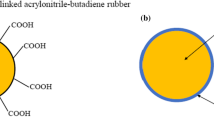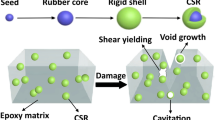Abstract
An epoxy resin, cured using an anhydride hardener, has been modified by the addition of preformed core–shell rubber (CSR) particles which were approximately 100 or 300 nm in diameter. The glass transition temperature, T g, of the cured epoxy polymer was 145 °C. Microscopy showed that the CSR particles were well dispersed through the epoxy matrix. The Young’s modulus and tensile strength were reduced, and the glass transition temperature of the epoxy was unchanged by the addition of the CSR particles. The fracture energy increased from 77 J/m2 for the unmodified epoxy to 840 J/m2 for the epoxy with 15 wt% of 100-nm diameter CSR particles. The measured fracture energies were compared to those using a similar amount of carboxyl-terminated butadiene-acrylonitrile (CTBN) rubber. The CTBN particles provided a larger toughening effect when compared to CSR particles, but reduced the glass transition temperature of the epoxy. For the CSR-modified epoxies, the toughening mechanisms were identified using scanning electron microscopy of the fracture surfaces. Debonding of the cores of the CSR particles from the shells was observed, accompanied by plastic void growth of the epoxy and shell. The observed mechanisms of shear band yielding and plastic void growth were modelled using the Hsieh et al. approach (J Mater Sci 45:1193–1210). Excellent agreement between the experimental and the predicted fracture energies was found. This analysis showed that the major toughening mechanism, responsible for 80–90% of the increase in fracture energy, was the plastic void growth.





Similar content being viewed by others
References
Drake RS, Siebert AR (1975) SAMPE Q 6:11
Kinloch AJ, Shaw SJ, Tod DA, Hunston DL (1983) Polymer 24:1341. doi:10.1016/0032-3861(83)90070-8
Kinloch AJ (2003) MRS Bull 28:445
Rowe EH, Siebert AR, Drake RS (1970) Mod Plast 47:110
Pearson RA, Yee AF (1986) J Mater Sci 21:2475. doi:10.1007/BF01114294
Pascault JP, Williams RJJ (1999) In: Paul DR, Bucknall CB (eds) Polymer blends, volume 1: formulation. Wiley, New York
Bucknall CB, Partridge IK (1983) Polymer 24:639. doi:10.1016/0032-3861(83)90120-9
Kinloch AJ, Yuen ML, Jenkins SD (1994) J Mater Sci 29:3781. doi:10.1007/BF00357349
Day RJ, Lovell PA, Pierre D (1997) Polym Int 44:288
Qian JY, Pearson RA, Dimonie VL, Elaasser MS (1995) J Appl Polym Sci 58:439
Shen J, Zhang Y, Qiu J, Kuang J (2004) J Mater Sci 39:6383. doi:10.1023/B:JMSC.0000043763.65417.4f
Pearson RA, Yee AF (1991) J Mater Sci 26:3828. doi:10.1007/BF01184979
Lin K-F, Shieh Y-D (1998) J Appl Polym Sci 70:2313
Becu-Longuet L, Bonnet A, Pichot C, Sautereau H, Maazouz A (1999) J Appl Polym Sci 72:849
Day RJ, Lovell PA, Wazzan AA (2001) Compos Sci Technol 61:41
Hayes BS, Seferis JC (2001) Polym Compos 22:451
Young RJ, Beaumont PWR (1975) J Mater Sci 10:1343. doi:10.1007/BF00540824
Spanoudakis J, Young RJ (1984) J Mater Sci 19:473. doi:10.1007/BF00553571
Amdouni N, Sautereau H, Gerard JF (1992) J Appl Polym Sci 46:1723
Lee J, Yee AF (2000) Polymer 41:8363
Kawaguchi T, Pearson RA (2003) Polymer 44:4239
Kitey R, Tippur HV (2005) Acta Mater 53:1167
Kinloch AJ, Lee JH, Taylor AC, Sprenger S, Eger C, Egan D (2003) J Adhes 79:867
Kinloch AJ, Mohammed RD, Taylor AC, Eger C, Sprenger S, Egan D (2005) J Mater Sci 40:5083. doi:10.1007/s10853-005-1716-2
Ragosta G, Abbate M, Musto P, Scarinzi G, Mascia L (2005) Polymer 46:10506
Zhang H, Zhang Z, Friedrich K, Eger C (2006) Acta Mater 54:1833
Kinloch AJ, Masania K, Taylor AC, Sprenger S, Egan D (2008) J Mater Sci 43:1151. doi:10.1007/s10853-007-2390-3
Sober DJ (2008) Personal Communication. Kaneka, Houston
ISO-527–1 (1993) Plastics—determination of tensile properties—part 1: general principles. ISO, Geneva
ISO-527–2 (1996) Plastics—determination of tensile properties—part 2: test conditions for moulding and extrusion plastics. ISO, Geneva
ISO-13586 (2000) Plastics—determination of fracture toughness (GIC and KIC)—linear elastic fracture mechanics (LEFM) approach. ISO, Geneva
Hsieh T-H, Kinloch AJ, Masania K, Sohn Lee J, Taylor AC, Sprenger S (2010) J Mater Sci 45:1193. doi:10.1007/s10853-009-4064-9
Fox TG (1956) Bull Am Phys Soc 1:123
Halpin JC, Pagano NJ (1969) J Compos Mater 3:720
Kerner EH (1956) Proc Phys Soc B 69:808
Nielsen LE (1966) J Appl Polym Sci 10:97
Ahmed S, Jones FR (1990) J Mater Sci 25:4933. doi:10.1007/BF00580110
Nielsen LE, Landel RF (1994) Mechanical properties of polymers and composites. Marcel Dekker, New York
Kinloch AJ, Taylor AC (2006) J Mater Sci 41:3271. doi:10.1007/s10853-005-5472-0
Fornes TD, Paul DR (2003) Polymer 44:4993
Luo J-J, Daniel IM (2003) Compos Sci Technol 63:1607
Halpin JC (1969) J Compos Mater 3:732
Halpin JC, Kardos JL (1976) Polym Eng Sci 16:344
Lewis TB, Nielsen LE (1970) J Appl Polym Sci 14:1449
McGee S, McCullough RL (1981) Polym Compos 2:149
Nielsen LE (1968) J Compos Mater 2:120
Kinloch AJ (1987) Adhesion and adhesives: science and technology. Chapman & Hall, London
Kunz SC, Beaumont PWR (1981) J Mater Sci 16:3141. doi:10.1007/BF00540323
Andrews EH (1968) Fracture in polymers. Oliver & Boyd, Edinburgh
Sue H-J (1991) Polym Eng Sci 31:275
Sue H-J (1991) Polym Eng Sci 31:270
Karger-Kocsis J, Friedrich K (1992) Colloid Polym Sci 270:549
Cheng C, Hiltner A, Baer E, Soskey PR, Mylonakis SG (1995) J Mater Sci 30:587. doi:10.1007/BF00356315
Azimi HR, Pearson RA, Hertzberg RW (1996) Polym Eng Sci 36:2352
Chen TK, Jan YH (1992) J Mater Sci 27:111. doi:10.1007/BF02403652
Guild FJ, Kinloch AJ, Taylor AC (2010) J Mater Sci 45:3882. doi:10.1007/s10853-010-4447-y
Huang Y, Kinloch AJ (1992) J Mater Sci 27:2763. doi:10.1007/BF00540703
Sultan JN, McGarry FJ (1973) Polym Eng Sci 13:29
Guild FJ, Young RJ (1989) J Mater Sci 24:298. doi:10.1007/BF00660971
Caddell RM (1980) Deformation and fracture of solids. Prentice-Hall, Englewood Ciffs
Guild FJ, Young RJ (1989) J Mater Sci 24:2454. doi:10.1007/BF01174511
Acknowledgements
The authors would like to thank Kaneka (D. Sober) and Nanoresins (S. Sprenger) for the supply of materials. They also acknowledge the EPSRC for a doctoral training award for K. Masania, and Becker Industrial Coatings for supporting G. Giannakopoulos. Some of the equipment used was provided by A.C. Taylor’s Royal Society Mercer Junior Award for Innovation.
Author information
Authors and Affiliations
Corresponding author
Rights and permissions
About this article
Cite this article
Giannakopoulos, G., Masania, K. & Taylor, A.C. Toughening of epoxy using core–shell particles. J Mater Sci 46, 327–338 (2011). https://doi.org/10.1007/s10853-010-4816-6
Received:
Accepted:
Published:
Issue Date:
DOI: https://doi.org/10.1007/s10853-010-4816-6




